Snares are the survivalist’s secret weapon for a few different reasons. They are inexpensive, they require very few materials to make, they are extremely effective with quite a high success rate, they are reliable, and they do not take much energy to make (preserving crucial caloric stores).
When you are in a survival situation, it is smart to consider your time and energy when doing anything. You must balance the cost in effort and burnt calories, with the payoff. The more you can benefit from any action and the less effort and cost to your resources it takes, the more you should focus on its use.
There is not one primitive culture, indigenous people, or any tribe where meat has not helped them survive. The way the human brain evolved was the amino acids and variety of proteins were made available by things like hunting.
Grey matter in humans is mostly free of amino acids from animals, compared to animal grey matter (Science Direct) which is a lower ratio. To support the growth of our brain, man had to consume proteins more than ever and a variety of foods, so hunting with traps and gathering methods evolved based on efficiency and success rates.
It would have been almost impossible to gather and consume enough calories from edible plants alone for survival before modern times, not even factoring in cold weather or season changes.
For modern times, there are luxuries that provide an option of not eating meat like modern equipment to farm, process food, transport food, and have it prepared and available in supply chains.
If those luxuries are once again removed, by SHTF, TEOTWAWKI, EMP, or another world-changing event, or even if you just want to live off the grid and go self-sufficient, meat will again come to the forefront if you want the best odds to survive.
Table of Contents
Are snares a more effective way to hunt?
As mentioned, the actual cost of your time, materials, and energy over the ratio of success. They are simple and wildly effective and can be made with locally sourced natural materials in a variety of ways.
Many of the ones found in Paleolithic times are still used today, and snares are considered to predate recorded history according to the Proceedings of the Tenth Vertebrate Pest Conference.
They made the association from seeing or comprehending animals and men getting snagged in vines, or maybe it was in traversing terrain searching for food, and in learning what to avoid by means of roots, holes, snagging foliage, etc they discovered a concept.
They applied the reasoning to making a means to capture the animal or enemy tribe (that may be a bigger or stronger one coming to loot your family and supplies by their own hand), hence setting the snare in their direction and for their personal needs where they want it vs. naturally occurring. In thinking on this, it would be an early use of tools in tactical thinking for survival.
In every conquering land acquisition or part of war snares and traps are mentioned, from Vikings and the Bayeux Tapestry and in many wars, up to today. Armies need to eat and when they run out of lead, they are an effective tool for use against man and animal.
This article is a focused overview complied of the different types of snares that can be used for survival on land, air, and sea. Snares may have more parts, especially the more complicated ones, but the base concept is always 3 main parts. That is a trip line and trigger, with an anchor somewhere.
Some may have evolved from rustic and primitive builds due to climate, animal, or terrain, but this is a guide comprised of only snares. The simplest form and design in many ways, and the most effective in others.
We have sorted the most useful in survival situations, and for the catch intended. We plan on following up one by one with DIY directions and I have set some presently to provide tips and hands-on use, and to see what I can catch, how fast, and since being on a trail cam, if the animal snared was able to escape and by what means, etc.
If there are any you’d like to see that are not on the list, just drop us a line and we would love to know what you are interested in!
Snares by Land
The basic Hangman’s Noose with a simple loop
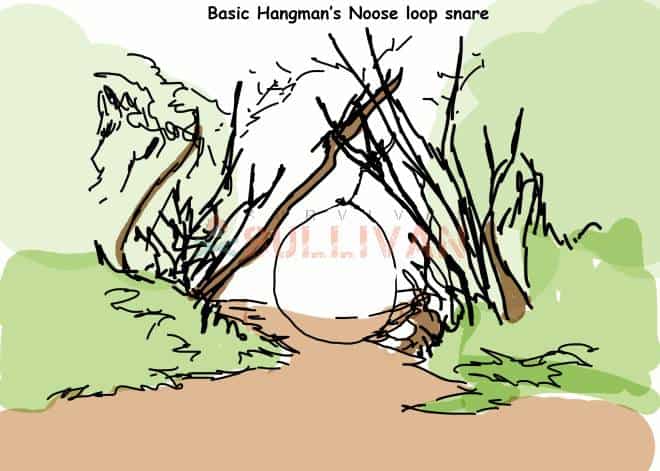
An example of a primitive snare is the basic Hangman’s Noose with a simple loop and a slip knot supported on brush. These were made of twisted bark, leather lashings, or braided hair. Snares like these were used by Indigenous peoples to trade fur with the Europeans in the New World.
19th Century snare with a bait stick
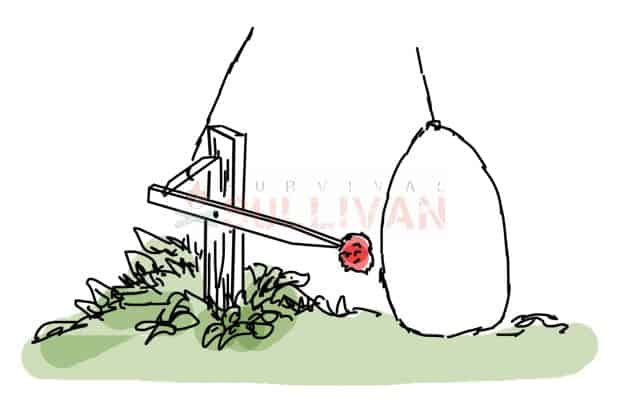
An example of a 19th Century snare with a bait stick, trigger mechanism, and wire. When copper, bronze, brass, and iron wire came on the market, snares were constructed of these materials to improve the strength of the snare.
Trappers also experimented and discovered by using a double twisted wire the animal cannot twist out of it, it actually tightens the trap, further securing the animal. Success rates grew with this innovation.
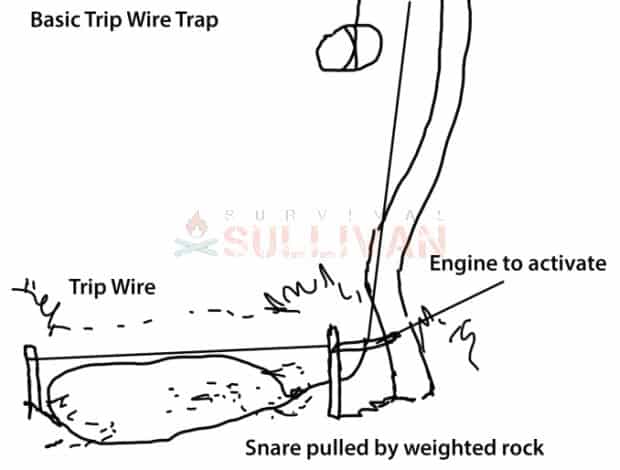
The Basic trip wire snare is a simple, yet very effective survival trap. It has an “engine” with a tension-balanced trigger piece. This can be modified for large or small game, and can be used for intruders’ legs.
A variation of this trap is with a net, or with bait. As with most of these traps, in survival situations, boot laces or paracord can be used in place of the wire. These are effective on migration and hunting trails, or on a path to a watering hole.
Mojave Scissor Trap
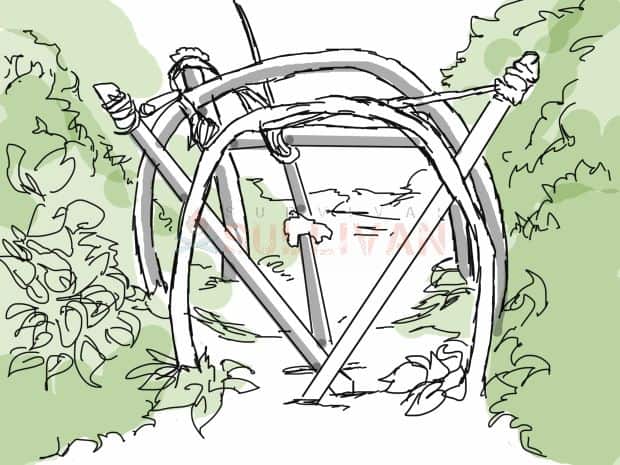
This spring-based trap is an antique design and can be recognized by the “V” that closes on the animal when it goes for the bait. The V acts as a fulcrum and is where the most force will be placed, performing lightning-fast like scissors on the animal’s neck once the tension is released.
This is a good alternative trap for animals that may be long bodied and prone to having their intestines damaged and leaking toxins in a deadfall trap.
The Treadle Snare
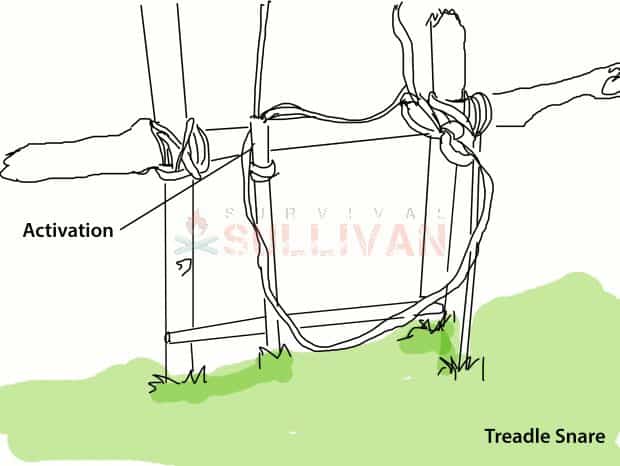
The treadle snare is used for small game and to acquire trail game. The bottom stick is adjusted with tension so it is best to use this with a channel to herd the animal into going through the opening.
Double Snare Spring trap
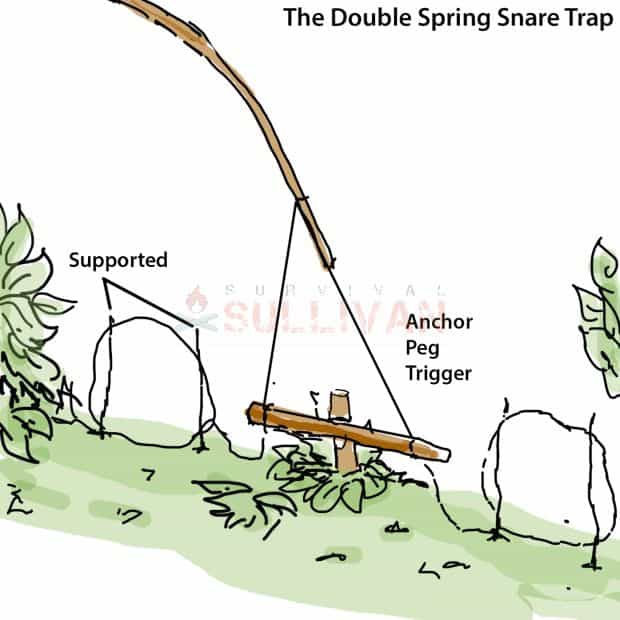
The double Snare Spring trap utilizes an anchor that doubles up on the Hangman’s noose to its full advantage.
Paiute Deadfall Trap
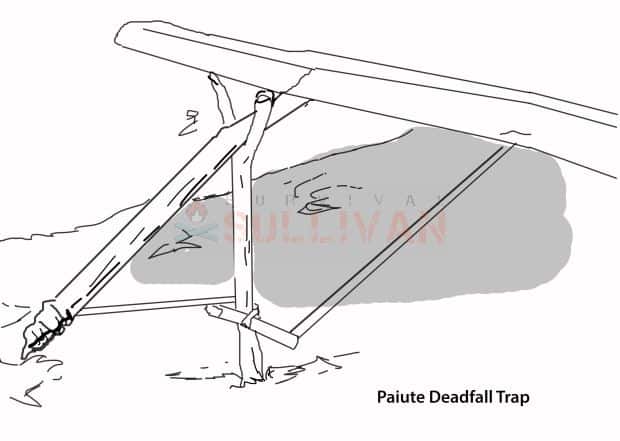
Paiute Deadfall trap is a trap known for its sensitive triggering mechanics resulting in successfully capturing small light bodied animals that may escape more traditional methods.
It has a 5 piece triggering system, but other than that is pretty simple and can be made from elements lying around pretty quickly.
Learn how to make the paiute deadfall trap here.
Small Game Deadfall Trap
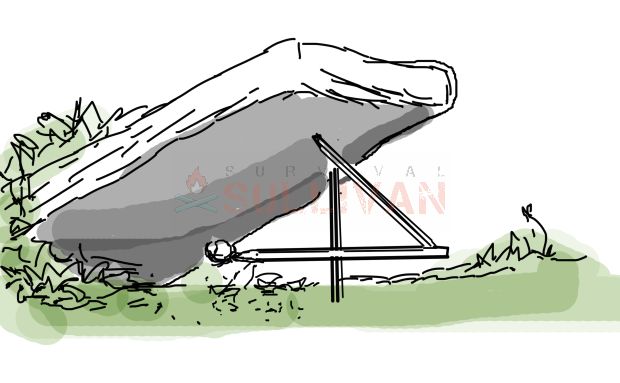
Small game deadfall trap This trap relies on an animal pulling the wired bait stick and basically, the weight of the rock will smash them. It is used for rabbits, squirrels, rats, pigeons, etc.
Scent-activated deadfall trap
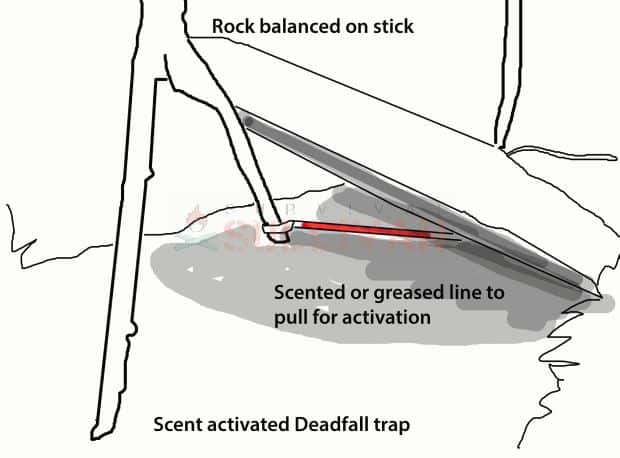
Scent activated deadfall trap is the small game trap, but instead of a baited trigger, the animal will pull a scented, or greased, line to activate the deadfall weight.
Scissor deadfall trap
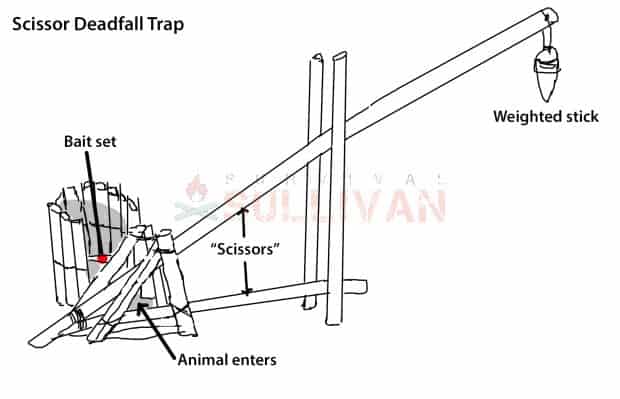
Scissor deadfall trap is a trap that engages a dynamic spring and a hammer arm that make for a quick death when the prey sticks his head through the “A” for the bait set.
Bird line snare
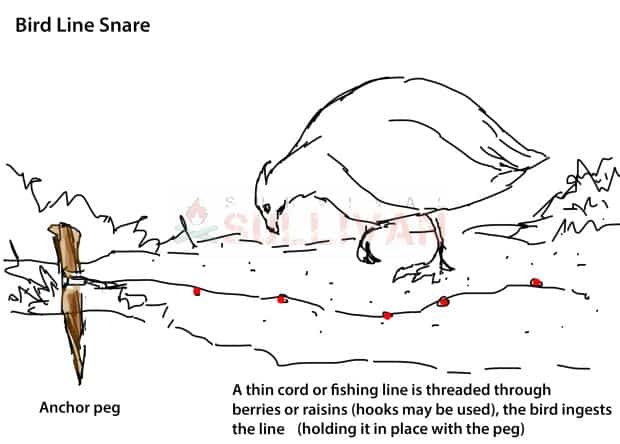
Bird line snare. This is an Old English method used for birds like pheasants and pigeons in corn stubble, grassy land or in hedgerows. Fishing line or very thin cord about 6 feet in length is strung through raisins and berries, there may be a hook used at the end in some variations, but the bird will ingest quite a good length and not be able to get away.
The Bow Trap
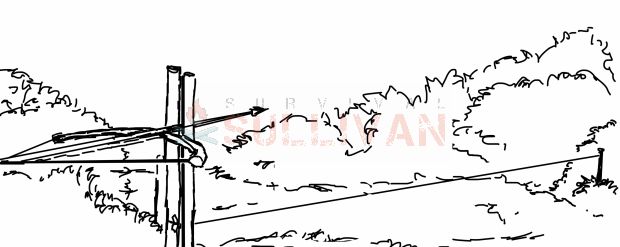
Bow trap uses a trip line to activate a bow and arrow set. This can be quite effective on larger prey like deer, elk, and bear.
Squirrel Pole Trap
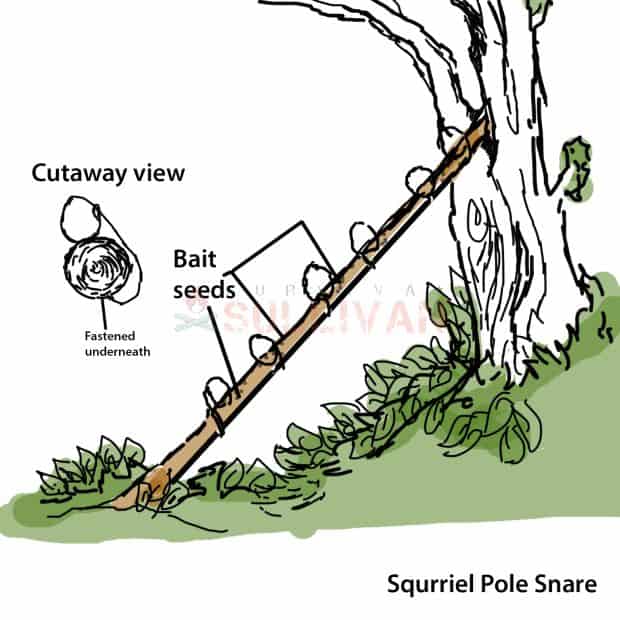
Squirrel pole trap is great for catching squirrels. All you need is some wire, a few screws, and a few poles. It is best used under a tree with a “drey”, a squirrel’s nest, so you can catch them on the way down. This is also good for mink, ermine, and weasel.
Tilong Small game snare
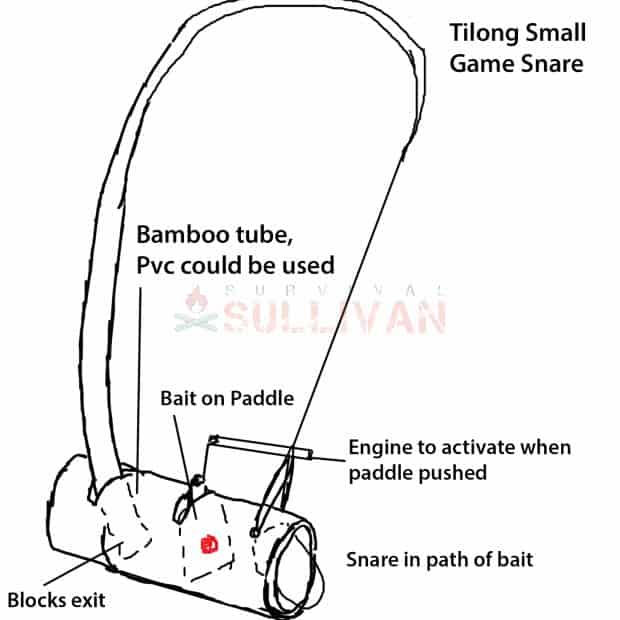
Tilong Small game snare uses a paddle and a whip pole that is set off by a complicated engine; this is used to capture animals like rats alive as they are trapped inside the tube until released.
Apache foot trap
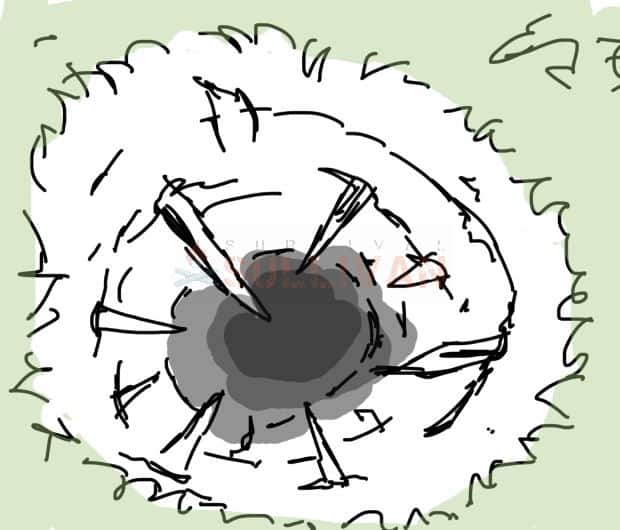
Apache foot trap was a trap for larger prey and intruders. It caught the animal by the leg and held them there, in many cases a snare was used across the hole too, so it is included.
The Atipil Snare
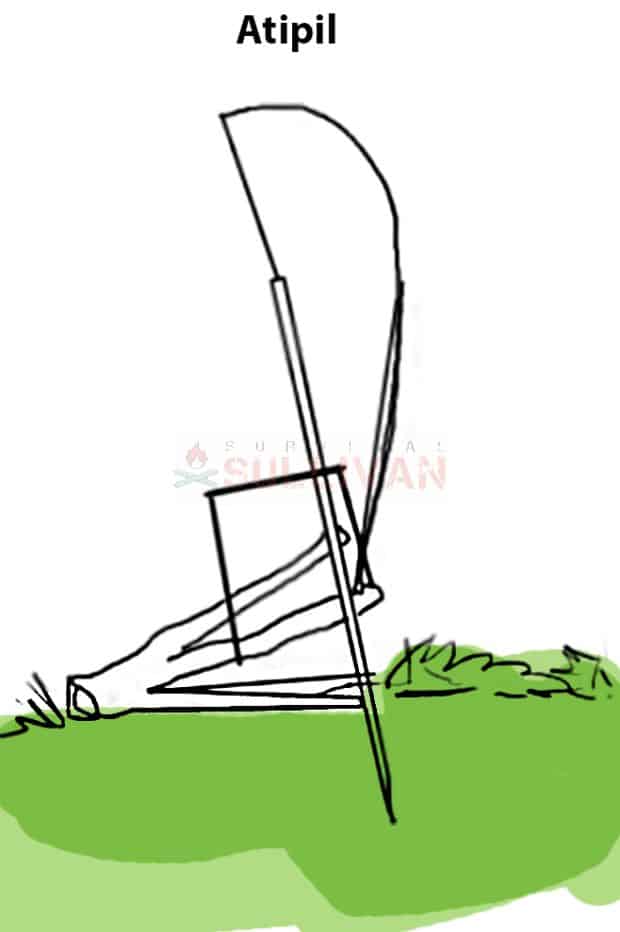
The Atipil Snare is a tension-based snare that plants the main action stick in the ground, and when activated the whip-like set will snare the animal by the neck.
This one is good for nesting grounds and small game. The trigger extends beyond the body of the trap, so it has a nice force. Nervous and quick animals can be caught with this.
The Bird Cup Trap
This simple trap requires a large cup, a binding agent such as honey, some seeds, and one or two sticks to secure the cup into place. The bird will go into the cup trying to eat the seeds and its wings will get stuck to the honey.
The reason this works so well is because birds have a hard time going backward. Here’s how to make it:
Snares by Air
Ojibwa bird pole snare
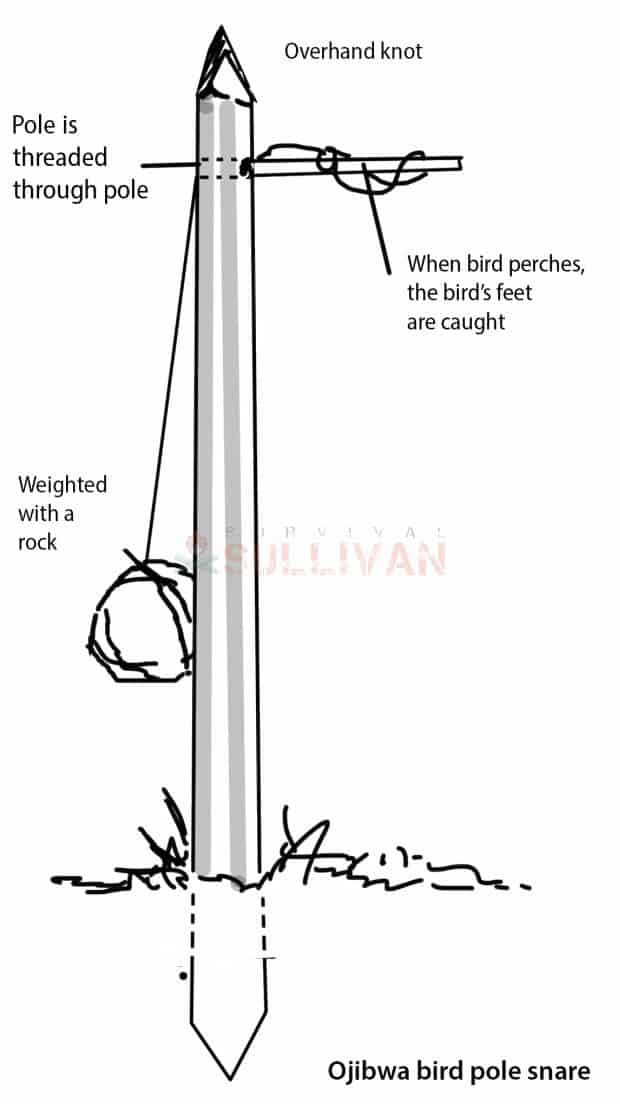
Ojibwa bird pole snare this one is a very old design used by Native Americans for hundreds of years. A 4-foot pole is set in a clearing to be a “perch” for birds.
When the bird lands, the weight sets the snare in action and it encloses around the bird’s feet. Do not use too heavy of a weight, as you may take off the legs and feet.
The Calayan Snare
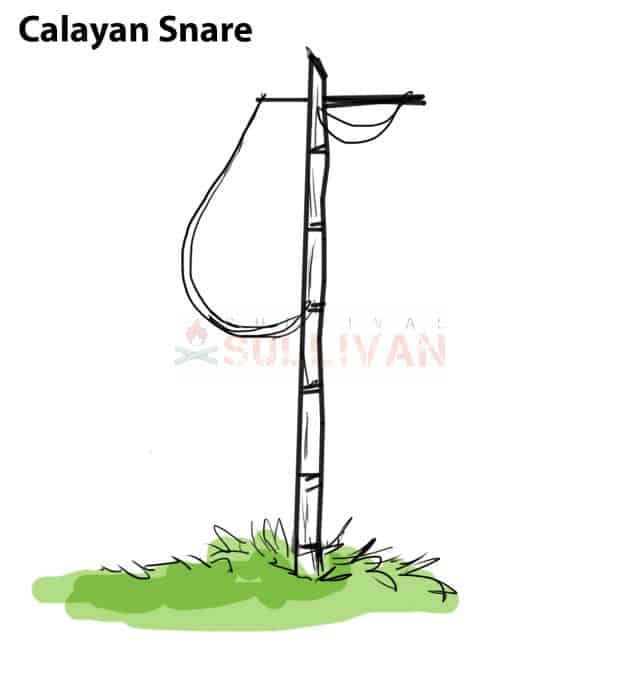
The Calayan Snare was developed on the Calayan islands to catch a mainstay of their diet, the thrush. Larger birds such as fishing hawks and the even bigger eagles can be caught with a modified version.
A four-foot pole is cut free from branches, but one is left to attach to a slip noose after being drawn back tightly. Birds grasp the bait and the whipping action catches their legs. This is a cousin to the Ojibwa pole.
Filipino Bird Snare
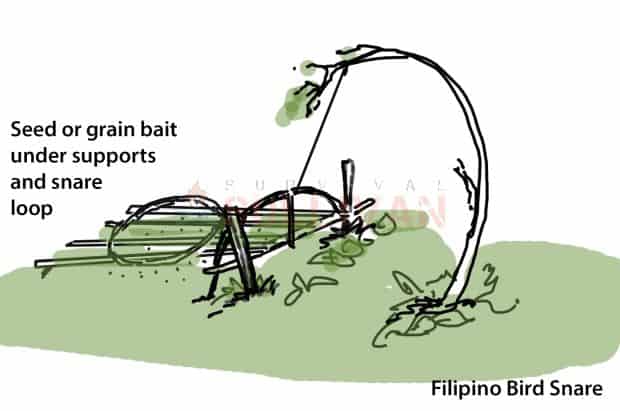
Filipino Bird Snare uses poles that lie across at an angle, and then bait is sprinkled over them. A short vertical stick and a crosspiece elevate the snare line. It has the advantage of being able to be activated anywhere on the trap surface.
When the trigger is activated, the whip pole catches the bird’s feet. This is a way to catch birds alive. Some variances dig shallow holes to make the bird work deeper for the corn. Any bird reaching its neck into the depression will get its head stuck in the noose.
The Ground Nest Snare
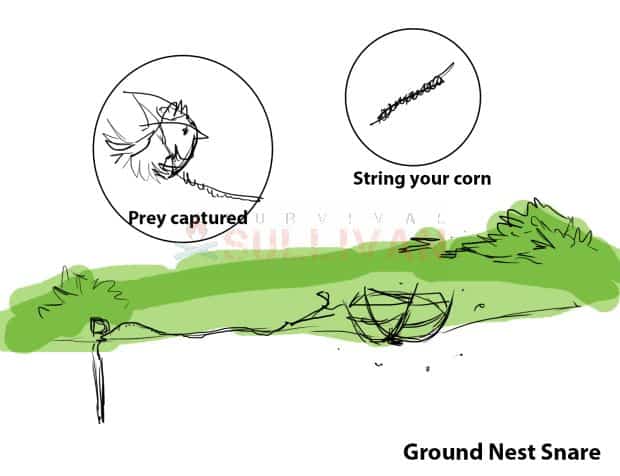
The Ground Nest Snare or Wild Cock Snare is for use over nests and below the ground line. A smaller version is used to catch ground-feeding birds by the forface.
A shallow pit is dug and then a corm is strung along the line to the buried nest. An anchor holds the snare in place as the bird is caught with this mini-net. It is quite effective for preening birds and birds’ nesting.
The Nest Snare
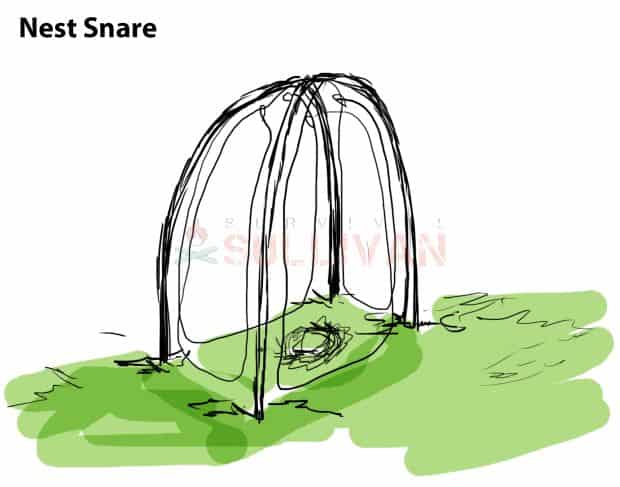
The Nest Snare is usually cup designed and the principle is that the snare is in suspension over the nest of the bird with strongly bent light bamboo pieces. The trap is placed so a returning bird can enter one of the sides and be caught in one of the four nooses.
The Landet snare
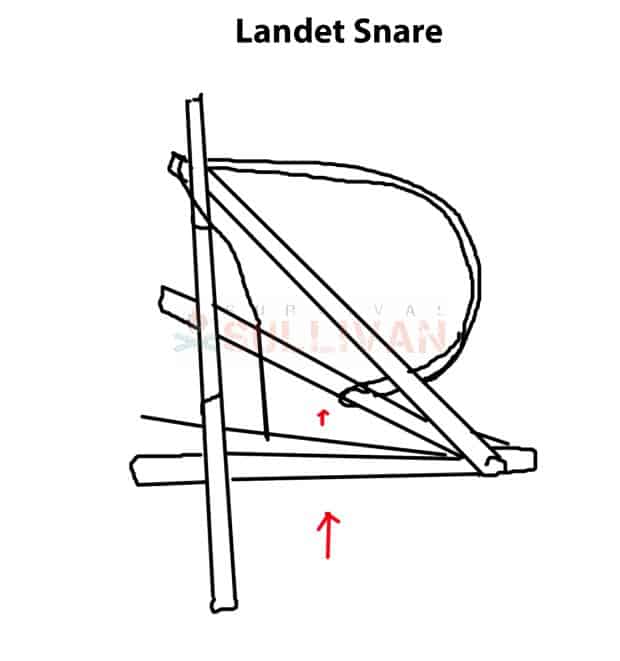
The Landet snare is a scissors spring type of trap that relies on tension over a noose closing on the head or neck. It utilizes a deadfall effect by scissoring the “V” shaped jaws of the trap to close the bamboo pieces on the prey. Button quail and migratory birds are caught quite well with this method.
The Igorote Lingan
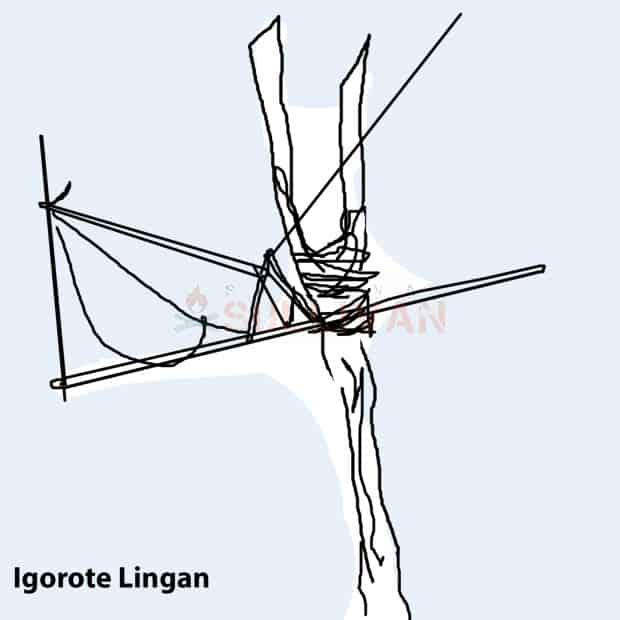
The Igorote Lingan is actually used to capture condors in the Caraballo Mountains, and is quite effective along cliff walls and by the entrances to small caves. This device consists of slender bamboo tied in horse hairs. It is put up above favorite bushes and shrubs, or any other favorite perches of the flocking birds as condors will perch there to hunt.
Snares by Sea
Wild Fowl rock snare
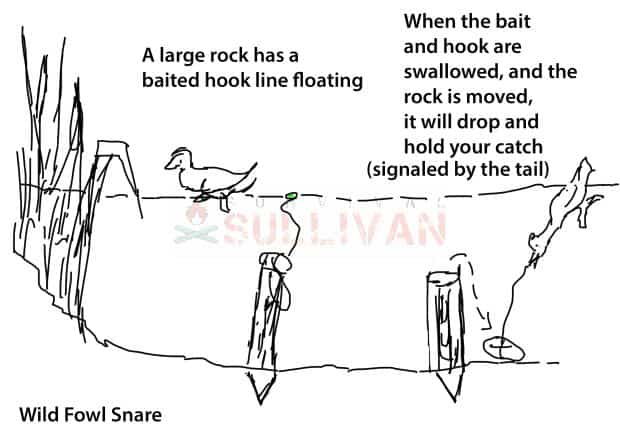
The wild Fowl rock snare was popularized mostly with duck, but any wild fowl can be caught if you have the right bait. A thick stake is driven into the water bed and a stone about 1/3 or ½ the duck’s weight is placed on top of it.
A bait line is attached to the stone, and when the bait is taken, the stone drags the bird underwater drowning it.
Drowning Snare Set
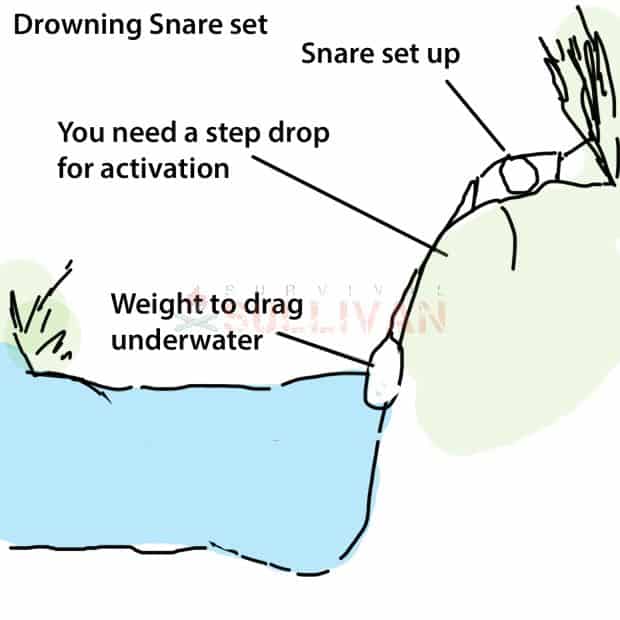
Drowning Snare Set uses a noose and activation with a steep hill. Once the trigger is activated, it pulls the animal down into the water source to await retrieval.
Night Line snare fishing
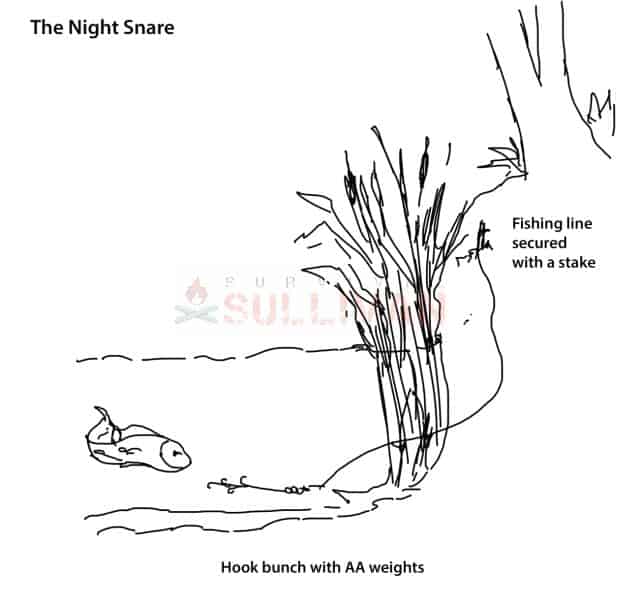
Night Line snare fishing. Considered by most as the best survival fishing snare as it requires little to no energy, this can be lifesaving when there may be little energy or strength to spare.
Many suggest using more than a few at once to capitalize on the fish when they are the most active, at midnight. Set them when night first falls, so when midnight comes around you are ready. Check them in the morning and claim your catches.
They are used for almost all types of fish, and it’s not uncommon when you snare a fish to have that fish turn out to be bait for another larger fish- you could get lucky and have Eel-pike-Bass like a Turducken!
Water Apache
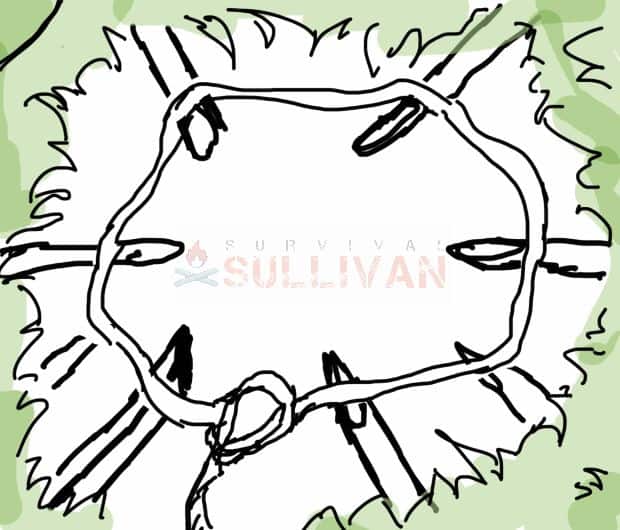
Water Apache. This is a variation of the apache foot trap, but placed in the water with a bait stick in the middle or buried bait. When used over a hole dug a few feet deep you can trap animals that may be leery of trails but need to come to the water to drink and prey on other animals there.
Many hunters would use these for gators. The biggest use was a beaver, especially when the fur trade started gathering steam and prices skyrocketed.
Wrapping Up
The key to survival, and especially when hunting by snare, is to utilize all resources you have and adjust and modify as you go. This is the best way to achieve success and the best tool you have is your reasoning and ability to evolve in these situations.
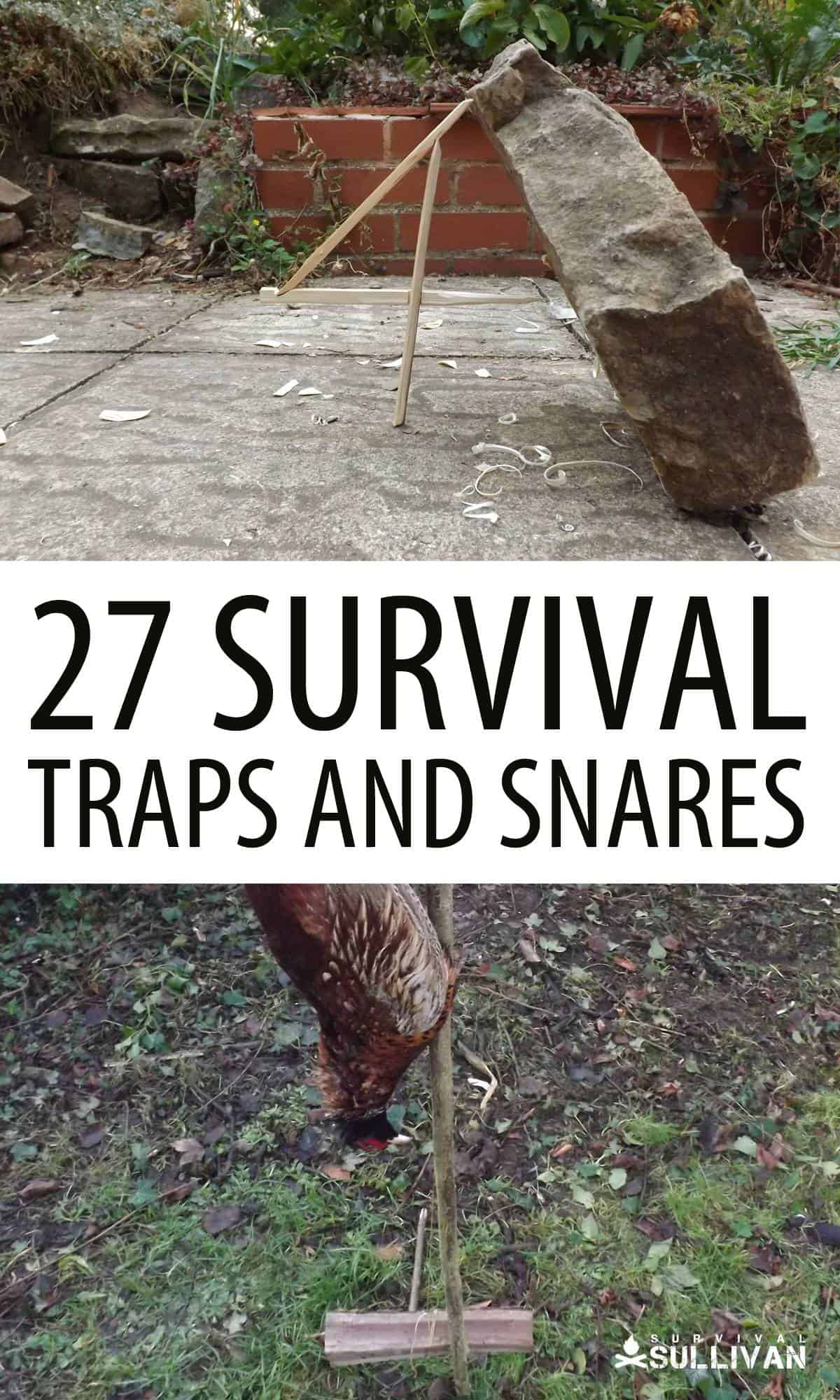
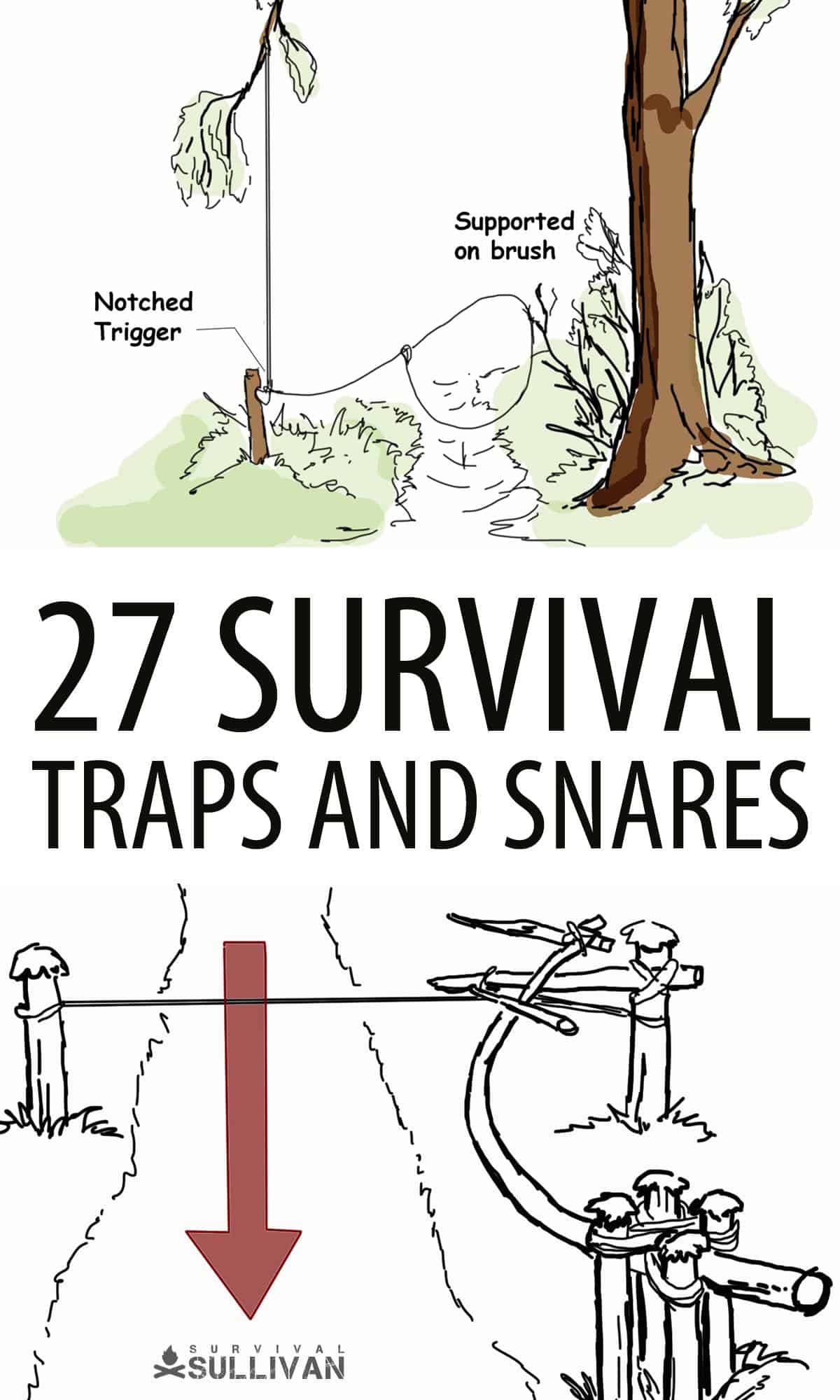

Growing up in the Bluegrass State, it was a point of familial pride to be able to shoot, trap, identify plants and track animals. Summer camps helped us be well versed in camping, weapons, and survival skills from a young age. We were surrounded by such a lush environment, and we used the resources we had.
I met my soulmate in my happiest place to be- a seemingly enchanted winding trail next to a beautiful wooded glen- where I spent as much time exploring as I could during daylight hours with my trusty four-legged friends.
The bucket list includes living the days painting and writing on a fully self-sufficient homestead, off-grid with our animals and family and plenty of land for the significant other (who I think is a true artist at weapons and living that way) to shoot to his heart’s content. Naturally organic living for us and the animals is a goal.

It is a good article on the types of traps and snares, but you have to practice these skills. Don’t think you can just go out and trap animals with no skills. Like everything else we do, PRACTICE,,,,,
Great article….
Been trapping/ snaring, hunting, camping and fishing since 1969. As a person who is survival minded, I read alot about the subject as well. I’ve seen all those images in many books. A few of those traps will work, but most are crap. They are much more complicated and difficult to set up than they appear. In a survival situation you really should keep it simple and stick with what you know works.
Fur trappers like me use steel cable for snares, and even these are one use only tools. Even a squirrel or muskrat will twist and booger up a steel snare so bad it cannot be used a second time. Do you really think some twisted up grass or bark will hold a squirrel? Good luck on that. Kill sets might work with 550 cord or boot laces. Squirrel pole is a good set. Usually a quick clean kill there. Practice.
Trapping is a whole industry and lifestyle of its own. To really get good, go to some of the local rendezvous, or trapping conventions. Talk to the people who have been doing it for years.
No, I do not think grass or bark will hold a squirrel hence the mention of wire use past the 19th century, “When cooper, bronze, brass and iron wire came on the market, snares were constructed of these materials to improve the strength of the snare. Trappers also experimented and discovered by using a double twisted wire the animal cannot twist out of it, it actually tightens the trap, further securing the animal. Success rates grew with this innovation.”
and wire mentioned in almost every trap, and when none of that use paracord or boot laces…it literally says that in the article, so no need to suggest that.
And here, as in most states, its illegal to trap at all so its not easy to learn by trial and error and no conventions.
Thanks for reading
great article, I can think of another one though. I believe this was am Australian one, it used a narrow bucket at water level to catch ducks. It is like a cup trap, but sunk to just above water level and baited with sinking seeds. The duck would dive into it, but unable to turn, and unable to back out into the air, would drown.
What do you think was used before there was wire? True they may escape more often but, that does not mean bark, grass. etc. won’t work on squirrels. If caught by the neck they can die before they can chew free. also some kinds of bark and grass are very tough.